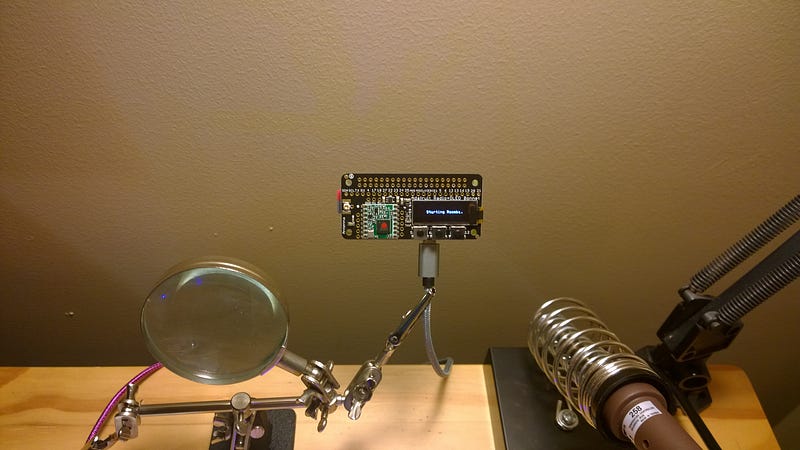Recently I've heard about multiple people working on con badges and decided to try my hand at a simple take on the idea.
Since I had just recently received my PyPortal Adabox I thought I would use that as my first platform to get started.
From the product page the PyPortal is:
An easy-to-use IoT device that allows you to create all the things for the “Internet of Things” in minutes. Make
custom touch screen interface GUIs, all open-source, and Python-powered using tinyJSON / APIs to get news, stock,
weather, cat photos, and more – all over Wi-Fi with the latest technologies. Create little pocket universes of joy that
connect to something good. Rotate it 90 degrees, it’s a web-connected conference badge #badgelife.Like many other
CircuitPython powered devices the PyPortal has a great Explore and Learn
page available that walks you through getting the right firmware installed as well as providing hardware breakdowns,
code demos and FAQ.
Once I had the PyPortal up to date and had gone through a couple demos I landed on having my first badge being a simple
menu systems. While many badges will contain easter eggs or ways to interact with other badges I decided to keep it
simple for this first run. I wanted my badge to be able to display a couple pieces of static data and have a couple
interactive options.
I landed on a Button menu that would show a couple maps, a photo of my badge, a countdown to Gen Con, and a simple D20
roller.
Along the way I made extensive use of the docs
and source code that Adafruit provides.
I also found it easy to find documentation for the module I would pull in from the library modules by referencing the
list of submodules on Read the Docs
While building my badge I ran into some interesting edges that I hope to explore further. I'm sharing these here just in
case somebody else reads this and can avoid similar pitfalls or suggest a different direction.
- Large buttons seem to lead to performance and OOM errors
- Originally my menu had 8 buttons (one with information about Adafruit, another with information about the project),
but that wasn't stable. After 3 or 4 clicks gc or something else couldn't keep up with the memory allocation and the
badge would crash with a MemoryError
- My schedule was also a menu of buttons originally. This let me setup a list of tuples I could manipulate in code, but
when I had 5 buttons span the screen render time was visibly slow, and lead to inconsistent OOM errors.
- Different fonts have different performance characteristics
- Looking back this makes sense. Different glyphs will have different structures. Depending on that a glyph can place
different loads on the system. I tried a few of the "performance" font from GoogleFonts, but ultimately landed on
Arial Bold for a font that looked consistent, rendered quickly and didn't have a large file size.
- Better ways to sleep?
- My badge spends a lot of time in the main super loop polling if a button has been pressed. At this time I don't think
CircuitPython supports interrupts. I hope in the future i can figure out a better was to let the device sleep, but
capture an interrupt type event such as the display being touched.
- PDB for CircuitPython
- I spent a lot of time running snippets in the REPL. This is a nice experience to have for an embedded device, but I do
miss having PDB or WebPDB to drop a breakpoint in my code, let it run and then inspect the stack, heap etc from a
given point in my program. I believe MicroPython contains this functionality so I'm guessing it's possible with
CircuitPython I just haven't dug in to make it happen yet.
Similar to the interesting behaviors I found above I learned a bit about developing with CircuitPython and how it can
differ from my day to day Python development along the way.
- Python data structure sizes
- Many code bases make liberal use of dictionaries. In fact some say that Python is built on top of the dict data
structure. It's incredibly useful to look items up by key, and provides some human readability over indexing into a
collection with no reference beyond position. That said Dictionaries are one of
the largest
builtin Python objects. One of the reasons for this is something called a load factor that I won't go into now, but
suffice to say as you add more objects to a dictionary and it approaches a given load factor it will automatically
grow in size. Because of this in a memory constrained environment I found myself removing dictionaries or list of
dicts and using more tuples and list of tuples.
- Take out the garbage
- Python Garbage Collection is handled via reference counting. Because of this it's important to think about when an
object (especially large objects ) you are using come in scope, and when they leave scope. In an environment like
CircuitPython you may also want to call gc.collect() when you leave scopes with large objects to make sure they are
garbage collected before you carry on. This can help avoid some OOM errors.
- Careful wih that indirection.
- I found myself removing helper functions and other pieces of code that helped keep things "clean". Often times I did
this because I was hitting performance of OOM errors that would go away when I put the functionality in the parent
scope. Because of this I have repeated code, and code that isn't what I would expect to pass code review day to day,
but it works, achieved stability and gave the performance I'm looking for on my badge.
- Testing and profiling for this environment is still a challenge for me.
- I would love to be able to write a test for my function and then profile that test to capture things like stack depth,
object sizes, timing, etc. And since I have a test I could do this N times to see what kind of behaviors emerge.
Instead right now I manually make a change and validate. Because of this I think I'm building an intuition of what is
happening, but I can't verify it which leads me to assume my understanding has gaps, and potentially wrong assumptions
today. Making this better can help me address the point above.
So with v1 of the badge prepared and ready for Gen Con 2019 I'm going to step back and work on some other items in this
space. While working on the project I found out that labels don't support an orientation flag. After mentioning this in
discord I opened an issue on Github with
some encouragement from @ladyada. Hopefully I can spend some cycles working on that.
I also continue to think about how to write tests for CircuitPython. Since the runtime is tied to the boards it's not as
simple as running the code in a CPython unittest environment. While there is a lot of overlap in the API and behavior
it's not a one to one match. I think being able to test the code would lead to faster development cycles and would open
the door to better profiling and understanding of my applications behavior.
Finally I plan to back up and read Making Embdedded Systems by Elicia White and visit some other embedded getting
started materials. While I had a lot of ideas for this project (and I'm happy with how it turned out) I realized that
since I'm not as familiar with this type of hardware environment I struggled at times to get the functionality I was
looking for with the performance I needed.
Thanks to the team at Adafruit. The devices they build and the creation of CircuitPython has lead me to pick up a hobby
that continues to be fun and encourages me to think in new ways about hardware and the programs I'm writing.
Additionally Adafruit has
a discord where
many people have been incredibly patient and helpful as I learn and ask questions.
I've really enjoyed working on this project. If you want to reach out feel free to follow up
via email or on.
You can find out more about the badge and source code in the repo
Some additional photos of the portal. I've ordered a case
off thingiverse , but using the Adabox case while I
wait.


